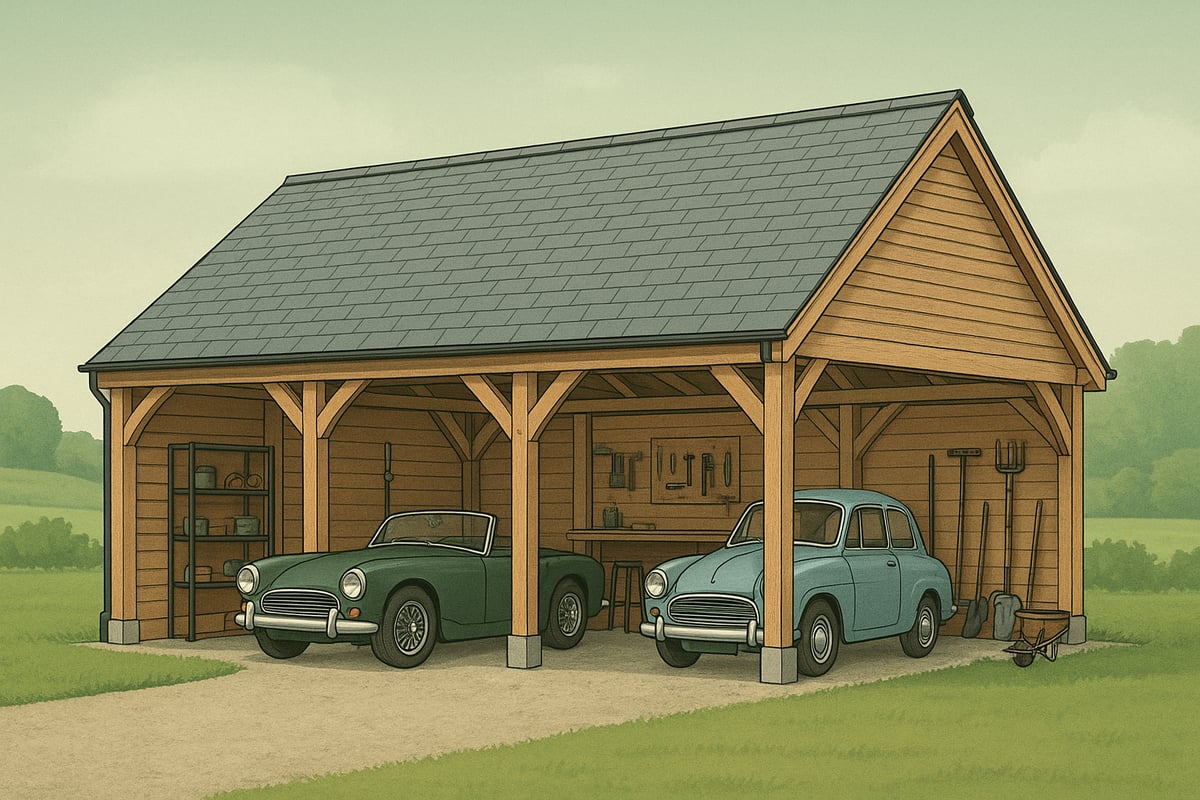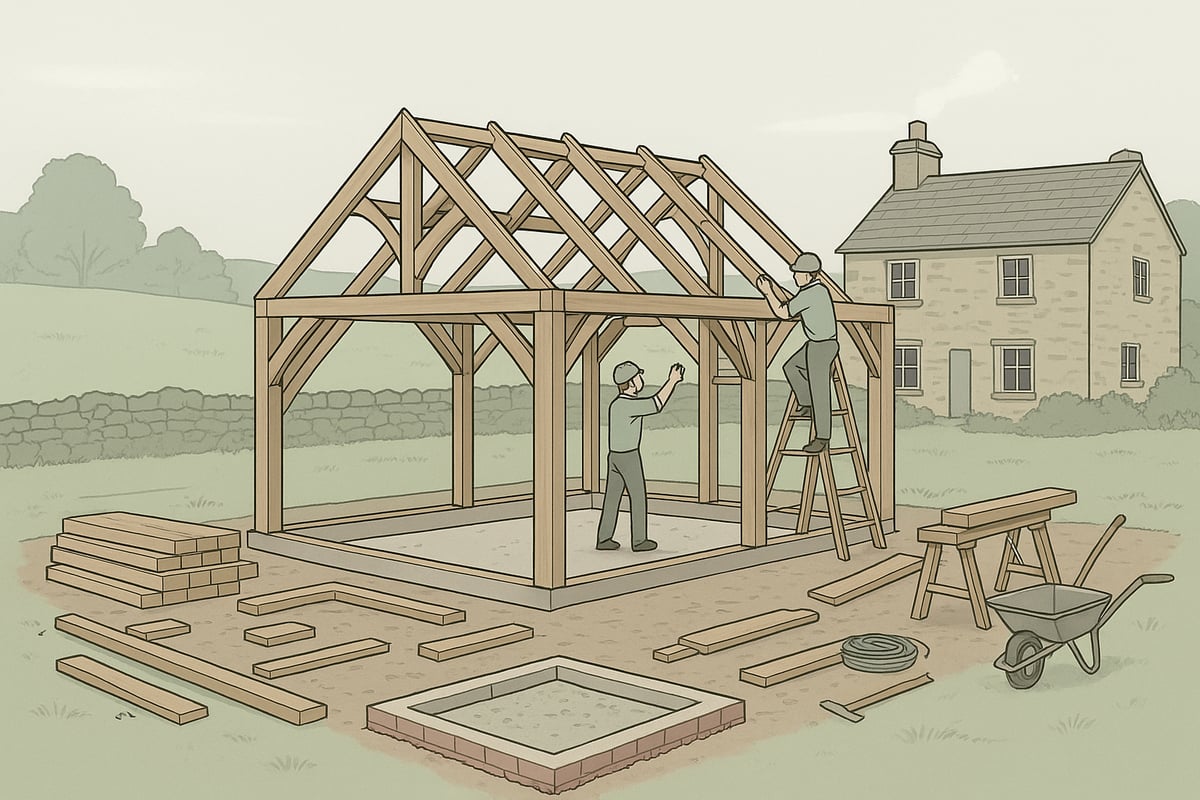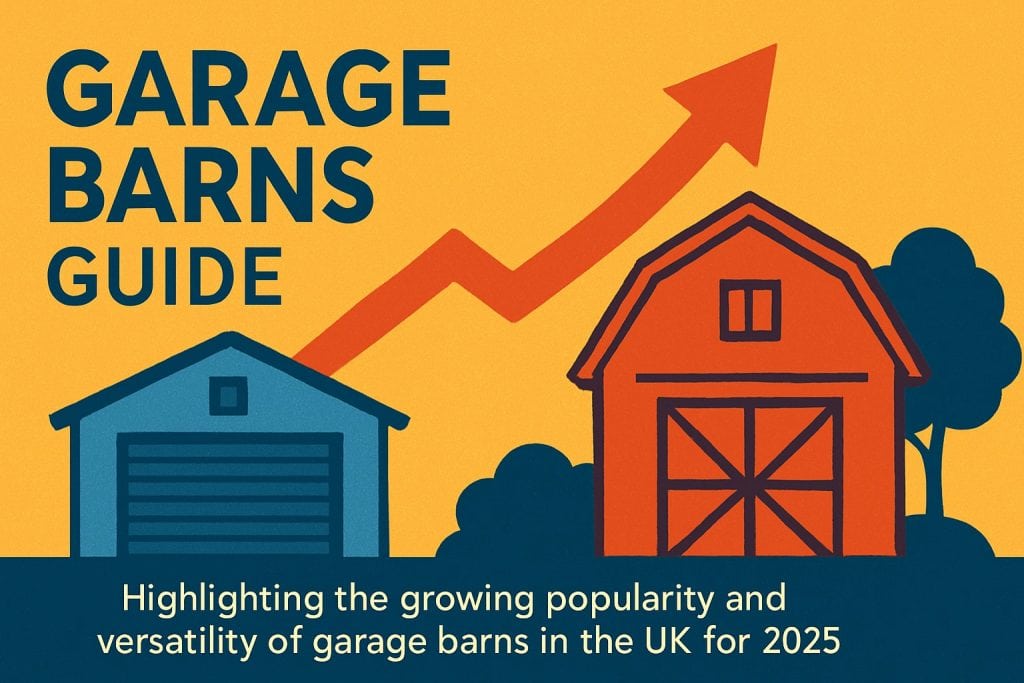Garage barns are capturing the interest of UK homeowners and developers in 2025, offering exceptional versatility for modern living. Whether you need secure storage, a creative workspace, or a flexible lifestyle solution, these structures are redefining property potential.
Building, designing, and optimising garage barns can boost property value, support sustainability, and adapt to changing needs. This guide provides a clear, step-by-step approach to planning, constructing, and enhancing your garage barn, with practical advice on design trends, construction processes, optimisation techniques, and regulatory requirements.
Understanding Garage Barns: Types, Uses, and Trends
Garage barns are a unique blend of traditional barns and modern garages, offering versatility and character for UK properties. Unlike standard garages, garage barns typically feature larger footprints, higher eaves, and flexible layouts. They can include storage lofts, workspaces, and multiple vehicle bays. Commonly constructed from timber, steel, or composite materials, these structures provide durability and adaptability for a range of needs.

What is a Garage Barn?
A garage barn stands out for its hybrid design, combining the spaciousness of a barn with the practicality of a garage. Typically, garage barns are larger than single garages and can be tailored with multiple bays, raised eaves, or loft spaces.
They are often built using robust materials like oak timber, galvanised steel, or composite panels. These buildings can be designed as open-plan spaces or partitioned for different uses. The flexibility of garage barns makes them suitable for both rural and urban settings, adapting to the needs of individual homeowners and developers.
Popular Uses for Garage Barns in 2025
The versatility of garage barns has made them increasingly popular for a wide range of applications in 2025. Many homeowners use garage barns for secure vehicle storage, home workshops, or hobby spaces.
Recent surveys show that 60 percent of UK homeowners cite multi-functionality as their top reason for investing in garage barns. Common adaptations include integrating gym areas, creating garden storage zones, or converting part of the space into guest accommodation or a home office. This adaptability ensures garage barns remain relevant as family and lifestyle needs evolve.
Key Garage Barn Trends for 2025
Several trends are shaping the design and use of garage barns in 2025. Sustainability is a key focus, with many opting for eco-friendly materials and energy-efficient features. Smart technology, such as automated doors and energy monitoring systems, is becoming standard in new builds.
Flexible, modular layouts are rising in popularity to future-proof garage barns for changing requirements. Aesthetic trends blend rural heritage with urban sophistication, resulting in structures that suit both countryside and suburban environments. These innovations make garage barns a forward-thinking investment for modern living.
Types of Garage Barns Available
There is a wide range of garage barns to suit different needs and budgets. Options include single-bay, double-bay, and multi-bay configurations, as well as raised eaves for additional headroom or storage. Prefabricated kits offer a quick and cost-effective solution, while bespoke builds allow for complete design flexibility.
For those interested in modular timber frame kits, self-build solutions are becoming more accessible. To explore the variety of bay configurations, visit the Bay Garage Barn Building Types page for detailed options.
Garage Barns and Property Value
Investing in garage barns can significantly enhance property value and market appeal. UK property surveys indicate that homes with high-quality outbuildings, such as garage barns, may experience up to a 10 percent uplift in resale value.
Buyers are increasingly attracted to properties that offer additional storage, workspace, and adaptable living areas. The robust construction and aesthetic charm of garage barns also contribute to a positive first impression, making them a sound investment for homeowners looking to boost both functionality and value.
Planning Your Garage Barn: Key Considerations
When planning garage barns, proper groundwork is key for a successful build in 2025. Each stage, from choosing the right plot to selecting a trusted supplier, can impact the outcome. Let us explore step-by-step considerations for a smooth and rewarding project.

Site Selection and Preparation
Selecting the right site for garage barns is a crucial first step. Begin with a thorough assessment of ground conditions. Check for stable soil, natural drainage, and potential flood risks. Good access for vehicles and construction machinery is essential.
Consider the orientation of your garage barns. South-facing doors maximise sunlight, while positioning away from trees helps prevent root damage. Always confirm property boundaries and check for easements that might limit construction.
A simple checklist for site selection:
- Stable, well-drained soil
- Adequate vehicle and machinery access
- Clear property boundaries
- No restrictive easements or covenants
- Optimal orientation for light and weather
Taking time at this stage avoids costly issues later and ensures your garage barns suit your daily needs.
Budgeting and Cost Factors
Budgeting is a major element in planning garage barns. Costs can vary significantly depending on size, materials, and finish. On average, a UK garage barn build ranges from £8,000 to £40,000. This estimate covers materials, labour, groundwork, and permits.
Breakdown of typical costs:
| Item | Estimated Cost Range |
|---|---|
| Materials | £3,000 – £20,000 |
| Labour | £2,000 – £12,000 |
| Groundwork | £1,000 – £5,000 |
| Permits/Fees | £500 – £3,000 |
Factor in additional expenses for insulation, smart technology, or bespoke features. Setting a clear budget from the outset helps avoid surprises and keeps your garage barns project on track.
Navigating UK Planning Permission
Understanding when planning permission is required is vital for garage barns. In many cases, outbuildings fall under permitted development rights, but larger or bespoke structures may need formal approval. Over 50% of new garage barn projects in the UK require some form of planning consent.
The application process involves submitting detailed plans, site maps, and sometimes environmental impact statements. Local authorities may require consultations with neighbours as part of the review.
For official guidance on compliance and requirements, consult the Building Regulations for Outbuildings. Ensure you keep all documentation, as it will be important for future property sales or modifications.
Sustainability and Material Choices
Sustainability is a growing priority for garage barns in the UK. Opting for responsibly sourced timber, such as oak, reduces environmental impact and offers excellent durability. Many suppliers offer certified timber that meets strict sustainability standards.
Eco-friendly choices extend to insulation and finishes. Natural wool, recycled materials, and low-VOC paints improve indoor air quality. Green building certifications can enhance the value and appeal of your garage barns.
Choosing sustainable options not only benefits the planet but also ensures your garage barns are efficient and future-ready.
Choosing Between Prefabricated Kits and Bespoke Builds
Garage barns can be constructed using prefabricated kits or bespoke builds. Prefabricated kits offer a cost-effective and quick solution, suitable for straightforward designs and self-builders. These kits often include pre-cut timber, fixings, and clear instructions.
Bespoke builds, on the other hand, provide maximum flexibility in size, layout, and finishes. They are ideal for homeowners with specific requirements or challenging sites. However, bespoke projects typically involve higher costs and longer timelines.
Consider your budget, timeline, and desired level of personalisation when deciding between kit and bespoke garage barns.
Timeline and Project Management
Effective project management is essential for timely completion of garage barns. Typical timelines range from several weeks for prefabricated kits to several months for bespoke builds. The process includes design, planning approval, groundwork, construction, and final fit-out.
Tips for successful project management:
- Set clear milestones for each stage
- Communicate regularly with contractors and suppliers
- Allow contingency time for weather or supply delays
- Document progress and decisions
Staying organised throughout ensures your garage barns meet expectations and remain within budget.
Acorn to Oak Framing: Timber Garage Barn Specialists
For those seeking expertise in garage barns, Acorn to Oak Framing stands out as a leading UK specialist. Their team combines traditional craftsmanship with contemporary design, offering both bespoke and modular solutions.
Acorn to Oak Framing uses sustainably sourced oak and complies fully with UK building regulations. Their end-to-end service covers consultation, design, construction, and aftercare. Transparent pricing and a strong reputation, backed by verified customer reviews, make them a trusted choice.
Choosing a specialist like Acorn to Oak Framing can streamline your garage barns project and deliver lasting value.
Designing Your Garage Barn: Aesthetic and Functional Choices
Designing garage barns in 2025 is about blending form with function. Modern homeowners seek spaces that enhance their lifestyle, add value, and serve a range of needs. Every detail, from the external look to the internal layout, contributes to a successful garage barn project.

Architectural Styles and Design Inspirations
Garage barns today come in a variety of architectural styles. Traditional designs often feature pitched roofs, exposed oak frames, and rustic cladding, echoing the classic barn look. Contemporary options favour clean lines, large windows, and minimalist detailing, which blend seamlessly with modern homes.
Matching the style of garage barns to the existing property is key. This ensures visual harmony and boosts curb appeal. Many choose hybrid designs, combining rural charm with urban sophistication, allowing garage barns to fit both country and city settings.
Maximising Interior Space and Layout
An efficient layout is essential for garage barns to fulfil multiple roles. Open-plan interiors suit those who want flexible space for vehicles, hobbies, or a workshop. Adding partitions creates dedicated zones, such as a home office or gym area, without sacrificing flow.
Consider incorporating mezzanines or lofts for extra storage or workspaces. Clever use of shelving and modular furniture also helps garage barns remain tidy and adaptable. These planning choices ensure the space remains functional as needs evolve.
Doors, Windows, and Access Points
The choice of doors and windows makes a significant impact on both usability and aesthetics in garage barns. Sliding, bi-fold, or up-and-over doors each offer unique benefits. For example, sliding doors save space, while bi-folds create wide openings perfect for larger vehicles or equipment.
Maximising natural light and ventilation is vital. Installing large windows or rooflights helps garage barns feel bright and inviting. Security is another priority, with robust locks, reinforced doors, and secure access points all playing a role in protecting what matters most.
Material and Finish Options
Selecting the right materials sets the tone for the entire project. Timber cladding, especially oak, is a popular choice for garage barns due to its natural beauty and durability. It provides excellent insulation and weathers gracefully over time.
Roofing options include clay tiles, slate, or metal sheeting, depending on the desired look and budget. Insulation is crucial for year-round comfort, particularly if garage barns are used as workshops or living spaces. Finishing touches like exposed beams add character and warmth.
Integrating Smart Features and Technology
Smart technology is transforming garage barns in 2025. Automated doors, app-controlled lighting, and integrated security systems are standard for modern builds. Energy efficiency is enhanced through smart thermostats and solar-ready designs, making garage barns future-proof.
For inspiration on the latest innovations, review the Garage Design Trends 2025 guide, which highlights new materials, lighting solutions, and tech integrations. These upgrades not only boost convenience but also support sustainability and long-term value.
Accessibility and Future-Proofing
Accessibility should never be overlooked in garage barns. Incorporating wide doorways, level thresholds, and easy-to-use fittings ensures the space is usable for everyone. Universal design principles make garage barns suitable for all ages and abilities.
Future-proofing is equally important. Modular layouts allow for easy expansion or reconfiguration as needs change. Planning for features like EV charging points or additional storage ensures garage barns remain relevant and valuable for years to come.
Building Your Garage Barn: Step-by-Step Process
Building garage barns in the UK requires a systematic approach. Each stage, from design to handover, is essential for quality, compliance, and long-term satisfaction. Below, we break down the process into clear steps, ensuring that your garage barns project runs smoothly and meets all expectations.

Step 1: Design Finalisation and Planning Approval
The journey to building garage barns starts with finalising your design. Work closely with an architect or specialist designer to create detailed plans that reflect your needs, whether you require extra storage, a workshop, or a multifunctional space.
Submit these plans to your local planning authority. Most garage barns will need planning permission, especially if they exceed permitted development limits or are located in sensitive areas. Prepare supporting documents such as site maps, elevations, and specifications.
A clear design and approved permissions provide a strong foundation for the rest of your garage barns project. Always confirm that your chosen design meets current UK building regulations before moving forward.
Step 2: Site Preparation and Foundation Work
Before construction begins, prepare the site for your garage barns. Clear the area of debris, vegetation, or old structures. Assess ground conditions to determine the best foundation type.
Foundation options include slab, strip, or pad, each offering varying levels of stability and cost. Proper drainage and orientation are crucial, ensuring that rainwater flows away from the structure and natural light is maximised.
A well-prepared site and solid foundation set the stage for a durable and long-lasting garage barns build. Always check boundary lines to avoid legal disputes later on.
Step 3: Framing and Structural Assembly
Once the foundation is ready, framing and structural assembly can begin. For timber garage barns, this involves erecting the main frame, securing posts, and connecting beams to form the skeleton of the building.
At this stage, you will choose between timber, steel, or hybrid frames. Timber remains popular for its sustainability and visual appeal. To understand the benefits and techniques involved, see the Post Frame Packages Overview, which details modern post-frame methods commonly used in garage barns.
Structural integrity is key. All joints and connections must be weatherproofed and checked for alignment. This ensures that garage barns remain safe and resilient for years to come.
Step 4: Roofing, Cladding, and Insulation
With the frame in place, the next step for garage barns is installing the roof and cladding. Choose roofing materials such as tiles, metal sheets, or shingles, considering both aesthetics and weather resistance.
Cladding options may include timber, composite panels, or steel. Insulation is essential, especially if the garage barns will be used year-round. Well-insulated walls and roofs improve energy efficiency and comfort.
Proper installation at this stage protects the interior from moisture, wind, and temperature extremes. Attention to detail here will pay off in the longevity of your garage barns.
Step 5: Doors, Windows, and External Features
Now, focus on fitting doors, windows, and other external features. For garage barns, select from sliding, up-and-over, or bi-fold doors, depending on access needs and space constraints.
Install windows to maximise natural light and ventilation. Consider security features such as reinforced locks, motion-sensor lighting, and CCTV. Add gutters and drainage to manage rainwater.
External finishes, like paint or wood stain, help protect garage barns from the elements. These choices also influence the building’s overall character and kerb appeal.
Step 6: Internal Fit-Out and Finishing
The internal fit-out stage transforms garage barns into functional spaces. Begin with electrical wiring, plumbing, and heating installations if required. Plan lighting, power points, and water supply based on intended use.
Finish interior walls with boarding or plaster, then install flooring suited to your activities. Consider built-in storage, shelving, or workbenches for added utility.
Final touches such as paint, fixtures, and fittings give garage barns a polished, practical finish. This step ensures your new structure is ready for everyday use.
Step 7: Final Inspection and Handover
Before using your garage barns, complete a thorough inspection. Check that all work meets UK building regulations and that safety standards have been followed.
Compile a snagging checklist to identify minor issues for correction. Once satisfied, your builder will officially hand over the garage barns, along with warranties and maintenance advice.
Keep all documentation, including plans and certificates, for future reference. With these steps completed, your garage barns are ready to deliver value, flexibility, and enjoyment for years to come.
Optimising Your Garage Barn for Efficiency and Longevity
Modern garage barns are long-term investments, so optimising for efficiency and durability is essential. Small improvements now can deliver substantial savings, comfort, and adaptability over time. Here is how to ensure your garage barns remain practical and valuable for years to come.
Energy Efficiency Upgrades
Enhancing the energy efficiency of garage barns is a priority for UK homeowners in 2025. Insulating walls, roofs, and floors prevents heat loss, while double-glazed windows maximise comfort and reduce energy bills. Solar panels are increasingly popular, providing renewable electricity and lowering running costs by up to 30%. Upgrading lighting to LED and installing smart thermostats further boost efficiency.
For those interested in modular or kit builds, the Timber Garage Kit Guide offers practical advice on integrating energy-saving features from the outset. These steps ensure garage barns remain comfortable and cost-effective throughout the seasons.
Storage and Organisation Solutions
Efficient storage is vital to maximising space in garage barns. Built-in shelving, overhead racks, and tool walls help keep items organised and accessible. Consider modular storage systems that can adapt to changing needs, offering flexibility for hobbies, equipment, or seasonal items.
Using labelled bins, pegboards, and fold-away workbenches can transform cluttered garage barns into streamlined, multi-functional spaces. Smart storage not only protects valuables but also enhances daily convenience.
Security and Safety Enhancements
Security is a top concern for garage barns, especially when storing vehicles or expensive tools. Install alarm systems, motion-sensor lighting, and reinforced doors to deter intruders. Window locks and security cameras provide added peace of mind.
Safety upgrades are equally important. Fit smoke detectors, fire extinguishers, and ensure clear access to exits. These measures protect both the structure and its contents, making garage barns safer for all users.
Maintenance and Upkeep
Regular maintenance extends the life and value of garage barns. Schedule inspections for signs of damp, pests, or structural movement. Timber barns require periodic treatments to prevent rot and weather damage.
Keep gutters clear, check roof tiles, and repair any damage promptly. Investing time in upkeep safeguards your garage barns against costly problems, ensuring they remain in top condition year-round.
Adapting Your Garage Barn for Changing Needs
Flexibility is a hallmark of well-designed garage barns. As needs evolve, consider converting spaces into home offices, gyms, or guest suites. Modular layouts make it easier to add features like EV charging points or additional storage.
Plan for technology upgrades and changing lifestyles, so garage barns continue to serve your family or business for decades. Future-proofing ensures enduring value and usability.
Regulations, Warranties, and Aftercare
Staying compliant with regulations is crucial when planning or upgrading garage barns. Understanding the rules, securing proper warranties, and organising aftercare can help protect your investment. This section covers everything you need to know to ensure your garage barns project remains secure, valuable, and future-proof.
Building Regulations and Compliance
All garage barns in the UK must adhere to relevant building regulations. These rules ensure structural safety, fire protection, and accessibility. For example, regulations cover aspects like foundations, insulation, and emergency exits. If you are converting an agricultural building into a garage barn, it is essential to understand Class Q permitted development rights, which may allow some changes without full planning permission.
Regulations vary by location and intended use. Always check with your local council before starting work. Ensuring compliance from the outset helps avoid costly delays or legal issues for garage barns.
Warranties and Guarantees
Most reputable suppliers and builders of garage barns offer warranties on both materials and workmanship. Standard warranties might last between 5 to 10 years, covering structural defects and major components. Always clarify what is included before signing any contract.
Look for aftercare packages that provide ongoing support, such as maintenance checks or emergency repairs. A comprehensive warranty increases buyer confidence and can add value to your property.
Insurance and Legal Considerations
Insuring garage barns is essential for protecting both the structure and its contents. Policies typically cover fire, theft, storm damage, and public liability. Premiums depend on factors such as location, security features, and usage.
When calculating insurance needs, consider the value of tools, vehicles, and equipment stored in garage barns. Specialist insurance may be required for business use. Always review what is and is not covered.
Documentation and Record-Keeping
Proper documentation is vital for garage barns. Keep copies of planning permissions, building regulation approvals, and warranty certificates. These documents are important for future property sales or when seeking insurance claims.
Organised records help demonstrate compliance and safeguard against disputes. Digital backups are recommended for long-term security.
Upgrades and Retrofitting Over Time
As technology and regulations evolve, upgrading garage barns becomes important. Common upgrades include adding insulation, improving security, or installing electric vehicle charging points. Retrofitting can also help older garage barns meet new standards.
Before making changes, check if additional permissions are needed. Staying proactive with upgrades ensures garage barns remain efficient, secure, and compliant for years to come.
Whether you are inspired by the versatility of garage barns, interested in sustainable and bespoke designs, or eager to optimise your property’s value, this guide has given you a clear path from planning right through to long-term care. If you are ready to transform your vision into a reality and want the confidence of working with a team renowned for quality, craftsmanship, and tailored solutions, now is the perfect moment to take the next step. Let’s make your dream garage barn a standout feature of your home—explore your options and BUILD NOW.












